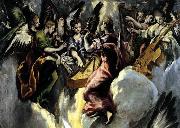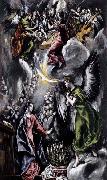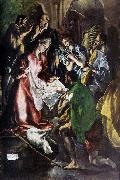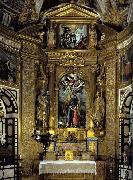
|
Artists
Index
|
||
|
GRECO, El
|
||
|
The Annunciation new21/GRECO, El-968923.jpg Gemälde IDENTIFIZIERUNG:: 62333 |
1596-1600 Oil on canvas Museo del Prado, Madrid Author: GRECO, El Title: The Annunciation (detail) , 1551-1600 , Spanish Form: painting , religious | |
| |
|
|
|
|
||
|
The Annunciation new21/GRECO, El-956586.jpg Gemälde IDENTIFIZIERUNG:: 62334 |
114 x 67 cm Thyssen-Bornemisza Collection, Madrid This painting is a remarkably fine reduced replica of one of El Greco's most haunting images, the Annunciation in the Prado, Madrid, that is almost three times as large. The Prado Annunciation formed the centre of the elaborate altarpiece commissioned from the artist in 1596 for the Colegio de Do?a Mar?a de Arag?n. El Greco's habit of making reduced replicas is amply documented. It is common knowledge that El Greco kept smaller, preliminary versions of almost all his works at home to show to his customers, and that he considered them finished, definitive works in themselves. Author: GRECO, El Title: The Annunciation , 1551-1600 , Spanish Form: painting , religious | |
| |
|
|
|
|
||
|
Adoration of the Shepherds new21/GRECO, El-555255.jpg Gemälde IDENTIFIZIERUNG:: 62335 |
1596-1600 Oil on canvas National Museum of Art of Romania, Bucharest The detail shows the lower part of the painting which was probably on the left of the retable of the Colegio de Do?a Maria. Author: GRECO, El Title: Adoration of the Shepherds (detail) , 1551-1600 , Spanish Form: painting , religious | |
| |
|
|
|
|
||
|
The Crucifixion new21/GRECO, El-233345.jpg Gemälde IDENTIFIZIERUNG:: 62336 |
1596-1600 Oil on canvas, 312 x 169 cm Museo del Prado, Madrid Christ on the Cross, at the moment of expiration, with the Virgin and Saint John, and at the foot of the Cross, the Magdalene. Probably originally above the Annunciation, in the retable of the Colegio of Do?a Mar?a. This painting and the Annunciation are the two widest of the series. Already, in Santo Domingo el Antiguo, the artist had sensibly related together in composition the two central paintings of the high altar, the Assumption and Trinity. Again, there is this compositional relationship of the two paintings, but there is also something more in this bringing together of the two so diverse yet intimately related themes of the Virgin's reception of the Holy Ghost, and Christ's giving up of the Holy Ghost. One subject represents one of the Joys of the Virgin, and the other incorporates one of Her Griefs. Each painting is divided horizontally in three. The figure of Christ of the Expiration is a continuation upwards of the central zone of the Annunciation with the Flames and the Dove; the figure of the Archangel Gabriel has its counterpart in the figure of Saint John; and the Virgin of Joy appears above as the Virgin of Grief. This painting of the Crucifixion is one of the great interpretations of the subject in painting and almost inevitably brings to mind two other great Crucifixions, Gr?newald's of the Isenheim Altar and Giotto's of the Arena Chapel. El Greco has introduced more of those symbols embodying spiritual emotions: the clamouring angels with outstretched arms encircling the Body of Christ - strangely recalling Giotto's painting - and the remarkable figure of the angel at the foot of the Cross. Author: GRECO, El Title: The Crucifixion , 1551-1600 , Spanish Form: painting , religious | |
| |
|
|
|
|
||
|
Altarpiece new21/GRECO, El-939969.jpg Gemälde IDENTIFIZIERUNG:: 62337 |
1597-99 - Capilla de San Jos? Toledo On 9 November 1597, El Greco signed a contract to execute a series of paintings for the newly built Capilla de San Jose (Chapel of Saint Joseph), Toledo. The contract specified that El Greco was to paint the altarpieces himself and design and gild the frames. The centrepiece of the decorative scheme was to be a painting of Saint Joseph and the Infant Christ with The Coronation of the Virgin above it. These two paintings, set in an altarpiece in a Palladian style designed by El Greco, though its surroundings were altered by Baroque additions around 1665, are still in situ; recent cleaning has revealed their masterly quality. In addition, El Greco was commissioned to paint two side altarpieces, Saint Martin and the Beggar hung on the left-hand side of the main altar, while The Virgin and Child with Saints Martina and Agnes was placed directly opposite, on the right-hand side of the altar, where they remained until they were sold in 1906 to the American collector Peter A. B. Widener, from his estate they entered the National Gallery of Art in Washington in 1942. The chapel was consecrated on 24 December 1594. At a later date, two sarcophagi were placed on either side of the main altar. Possibly designed by El Greco or his son Jorge Manuel, they are similar in design to the ark and the obelisk with a ball on top that appear in the background of El Greco's late Purification of the Temple from San Gin?s. Mart?n Ram?rez was buried to the left of the altar while Diego Ort?z and his wife were placed to the right, in each case with a plaque above stating that they were co-founders of the chapel. The two sculptures of David and Salomon, situated on either side of the main altar was possibly also designed by El Greco. Author: GRECO, El Title: Altarpiece , 1551-1600 , Spanish Form: painting , religious | |
| |
|
|
|
|
||
| Vorheriger Künstler | ||
|
Also Buy::. For Following Paintings / Artists / Products, Please Use Our Search Online: |










